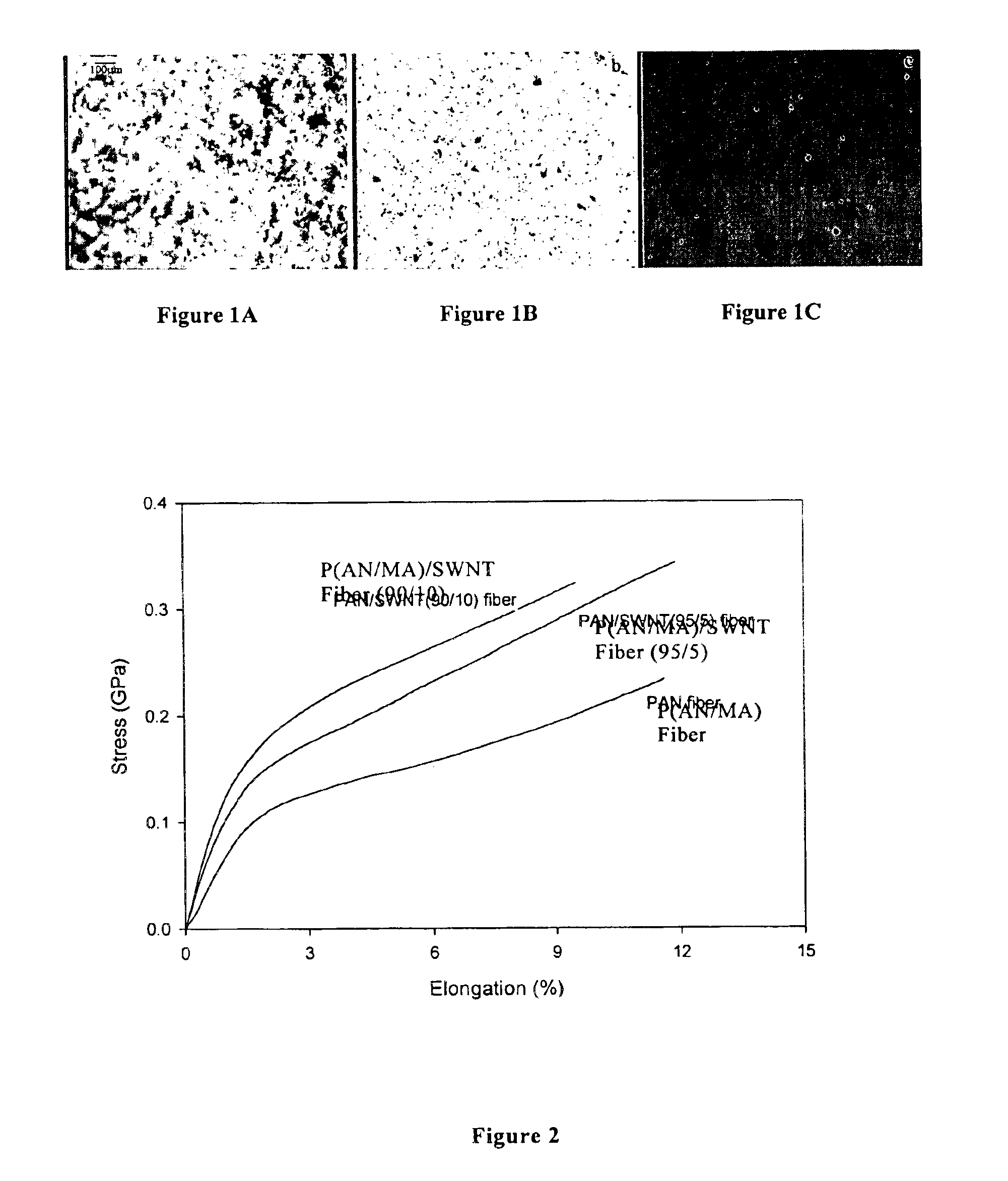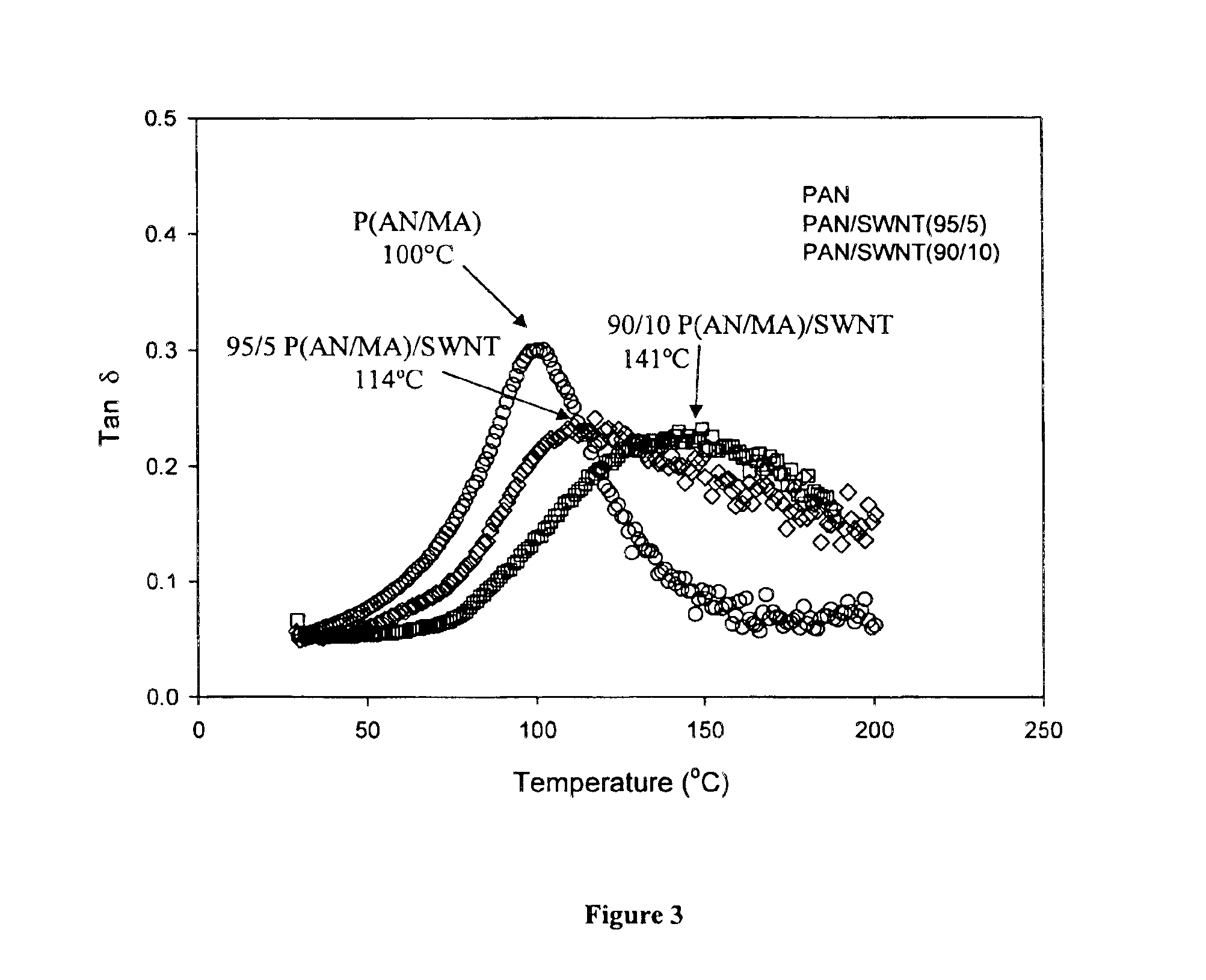Macroscopic fiber comprising single-wall carbon nanotubes and acrylonitrile-based polymer and process for making the same
a technology of acrylonitrile-based polymers and macroroscopic fibers, which is applied in the field of macroroscopic fibers comprising single-wall carbon nanotubes, can solve the problems of lack of significant enhancement of mechanical properties of nanotube-polymer composites, single-wall carbon nanotube dispersal, and inability to fully realize the potential of single-wall carbon nanotubes when incorporated, so as to increase the orientation and modulus of an acrylonitrile-containing poly
- Summary
- Abstract
- Description
- Claims
- Application Information
AI Technical Summary
Benefits of technology
Problems solved by technology
Method used
Image
Examples
example 1
[0061]This method demonstrates the preparation of a spinning dope of pure polyacrylonitrile-co-methyl acrylate (P(AN / MA) in dimethyl acetamide (DMAc) solvent. Total solids were 15 g in 100 g DMAc.
[0062]100 g DMAc was added to a 250-ml sample bottle and cooled to 0 to 5° C. using an ice jacket. About 30 mg oxalic acid, which is about 0.2% of the polymer weight, was added as an anti-gelling agent. 15 g finely powdered P(AN / MA) polymer from Sigma Aldrich, having a 90:10 acrylonitrile:methyl acrylate comonomer ratio and a Mn molecular weight of about 100,000 g / mole, was added step-wise to the DMAc in small quantities under constant stirring. The stirring was continued until the all of the polymer was dissolved and the solution was clear and optically transparent. This solution was used to make the polyacrylonitrile (P(AN / MA) control fiber.
example 2
[0063]Preparation of PAN-SWNT Solutions in DMAc
[0064]This example demonstrates the preparation of spinning dopes containing poly(acrylonitrile-co-methyl acrylate) (P(AN / MA)) and single-wall carbon nanotubes (SWNT) at different P(AN / MA):SWNT weight ratios in DMAc. For each P(AN / MA):SWNT ratio prepared in this example, the acrylonitrile copolymer, obtained from Sigma Aldrich, contained a 90:10 AN:MA comonomer ratio and a Mn molecular weight of about 100,000 g / mole. For each preparation in this example, single-wall carbon nanotubes (Lot No. HPR87), were obtained from Rice University, where they were made in a high temperature, high pressure, all-gas phase process through the disproportionation of carbon monoxide (CO) to SWNT and CO2 using iron as the transition metal catalyst. Furthermore, for each preparation in this example, sonication was done with a bath sonicator (Cole-Parmer Model 8891R-DTH), and homogenation was done with a bio-homogenizer (Biospec Products Inc., Bartlesville, O...
example 3
[0073]This example demonstrates the preparation of polyacrylonitrile-co-methyl acrylate, P(AN / MA), in dimethyl formamide (DMF) without nanotubes. The total solids are 15 g in 100 g DMF.
[0074]100 g DMF was added to a 250-ml bottle and cooled to 0 to 5° C. using an ice jacket. About 30 mg oxalic acid, about 0.2% of the polymer weight, was added as an anti-gelling agent. 15 g finely powdered P(AN / MA) copolymer (90:10 AN:MA comonomer ratio and Mn˜100,000 g / mole obtained from Sigma Aldrich) was added stepwise in small quantities under constant stirring. The stirring was continued until the entire polymer was dissolved and formed a clear, transparent solution. This solution was used make a control polyacrylonitrile (PAN) fiber.
PUM
| Property | Measurement | Unit |
|---|---|---|
| Fraction | aaaaa | aaaaa |
| Fraction | aaaaa | aaaaa |
| Pressure | aaaaa | aaaaa |
Abstract
Description
Claims
Application Information
 Login to View More
Login to View More - R&D
- Intellectual Property
- Life Sciences
- Materials
- Tech Scout
- Unparalleled Data Quality
- Higher Quality Content
- 60% Fewer Hallucinations
Browse by: Latest US Patents, China's latest patents, Technical Efficacy Thesaurus, Application Domain, Technology Topic, Popular Technical Reports.
© 2025 PatSnap. All rights reserved.Legal|Privacy policy|Modern Slavery Act Transparency Statement|Sitemap|About US| Contact US: help@patsnap.com



